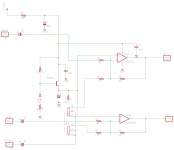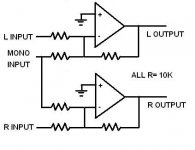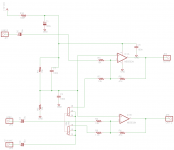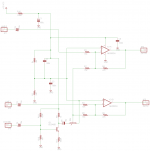Hi all,
I am building a boombox for "street artist" use.
I need line input for MP3 player and a dynamic mic input.
So I need some kind of circuit for:
1)raising the MP3 reader input of a factor of 3 (to get close to 2 Vrms that the power amp would like)
2)raising the mic input 0 to 16 db adjustable.
3) mixing the things
I have designed the following, as the most simple solution possible, with the following assumptions:
a)the line output level can be cut using the player volume.
b)the power amp is AC coupled , and 20k input .
c)mic is non balance short cable dynamic cartridge.
d)inverted output phase is not a problem
I am not sure that the voltage splitter is really necessary, though.
Maybe a simple 2 x 10k resistors would do fine.
Do you see any gross mistake?
Thanks in advance
I am building a boombox for "street artist" use.
I need line input for MP3 player and a dynamic mic input.
So I need some kind of circuit for:
1)raising the MP3 reader input of a factor of 3 (to get close to 2 Vrms that the power amp would like)
2)raising the mic input 0 to 16 db adjustable.
3) mixing the things
I have designed the following, as the most simple solution possible, with the following assumptions:
a)the line output level can be cut using the player volume.
b)the power amp is AC coupled , and 20k input .
c)mic is non balance short cable dynamic cartridge.
d)inverted output phase is not a problem
I am not sure that the voltage splitter is really necessary, though.
Maybe a simple 2 x 10k resistors would do fine.
Do you see any gross mistake?
Thanks in advance
Attachments
Last edited:
I concour that the power splitter transistor can be eliminated (see modified schematics).
But the rest of your circuit is exaxctly like mine . R9 just lets you set the gain of the mic input between circa 0 and 16 dB, without altering the gain of the line input. R9 can be seen as an extension of R7 and R8. And BTW, I need some 4-6 dB gain on the line in as well.
Do you mean it won't work like that ? Can you explain me why?
But the rest of your circuit is exaxctly like mine . R9 just lets you set the gain of the mic input between circa 0 and 16 dB, without altering the gain of the line input. R9 can be seen as an extension of R7 and R8. And BTW, I need some 4-6 dB gain on the line in as well.
Do you mean it won't work like that ? Can you explain me why?
Attachments
Last edited:
Thanks for the nice worrds.
Yes hfe >100 (at 5 mA Ic it should be around 300 for the quoted type). With the quoted values you could probably direct couple the BJT to the op-amp, but you probably would need to put a trimmer in the input divider to fine adjust the DC offset, and I do not think it is worth.
Note that the Re is not shunted by capacitor so the gain is reasonably independent from hfe and set around 10.
But my question holds: what are the real advantages of this more complicate circuit?
Yes hfe >100 (at 5 mA Ic it should be around 300 for the quoted type). With the quoted values you could probably direct couple the BJT to the op-amp, but you probably would need to put a trimmer in the input divider to fine adjust the DC offset, and I do not think it is worth.
Note that the Re is not shunted by capacitor so the gain is reasonably independent from hfe and set around 10.
But my question holds: what are the real advantages of this more complicate circuit?
Last edited:
"...Note that the Re is not shunted by capacitor so the gain is reasonably independent from hfe and set around 10...."
Yes, and is more linear.
Post # 4 has constant input impedance on the mike line...
Post # 3 has input impedance that varies with gain setting...I just don't like this as a variable on a dynamic mike input.
Now that I think about it, what input Z does your dynamic mike need?
You might need to increase the resistor values in the bias chain.
Just a thought.

Yes, and is more linear.
Post # 4 has constant input impedance on the mike line...
Post # 3 has input impedance that varies with gain setting...I just don't like this as a variable on a dynamic mike input.
Now that I think about it, what input Z does your dynamic mike need?
You might need to increase the resistor values in the bias chain.
Just a thought.
"...Note that the Re is not shunted by capacitor so the gain is reasonably independent from hfe and set around 10...."
Yes, and is more linear.
Post # 4 has constant input impedance on the mike line...
Post # 3 has input impedance that varies with gain setting...I just don't like this as a variable on a dynamic mike input.
Now that I think about it, what input Z does your dynamic mike need?
You might need to increase the resistor values in the bias chain.
Just a thought.

Impedance should be ok. Mikes like the Shure M57 have 2-300 Ohm impedance. If my hfe is around 300 I should be around 7k, so I do not see problems with dynamic mikes using the BJT input.
With the other simpler circuit, I might get some plateau effect at the extreme end of the regulation, (i.e. when the pot i completely short) but not really something to be afraid of, IMO.
On the other hand, the circuit with the BJT is more clipping-prone (you can get something like 1 V RMS out of a good mike, if the rocker is really screaming
- Status
- This old topic is closed. If you want to reopen this topic, contact a moderator using the "Report Post" button.
- Home
- Source & Line
- Analog Line Level
- Pre-mix for boombox



